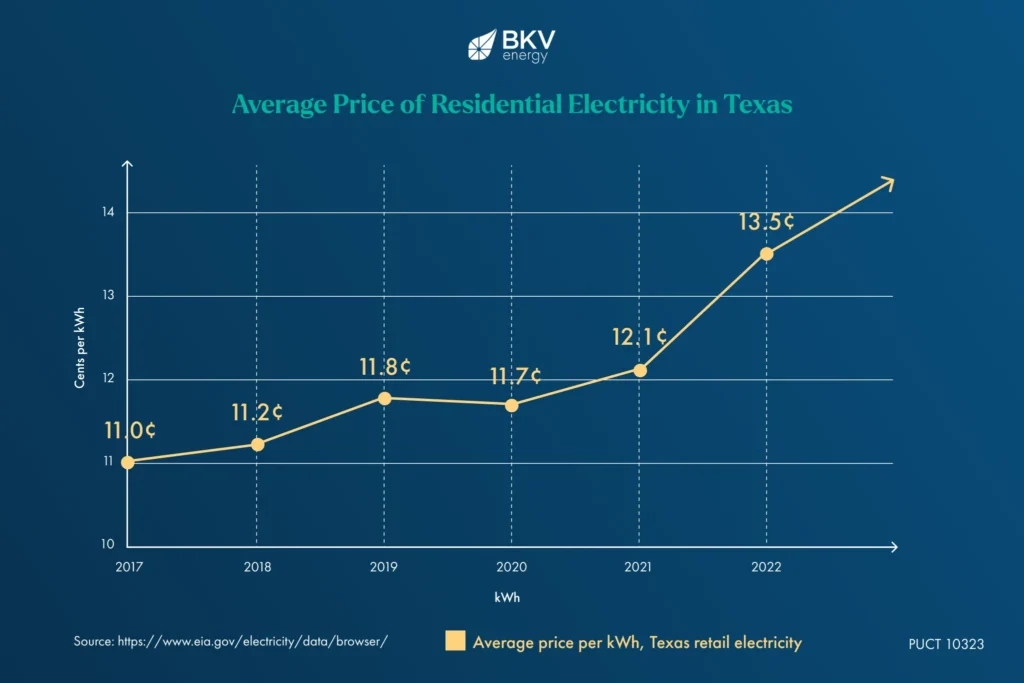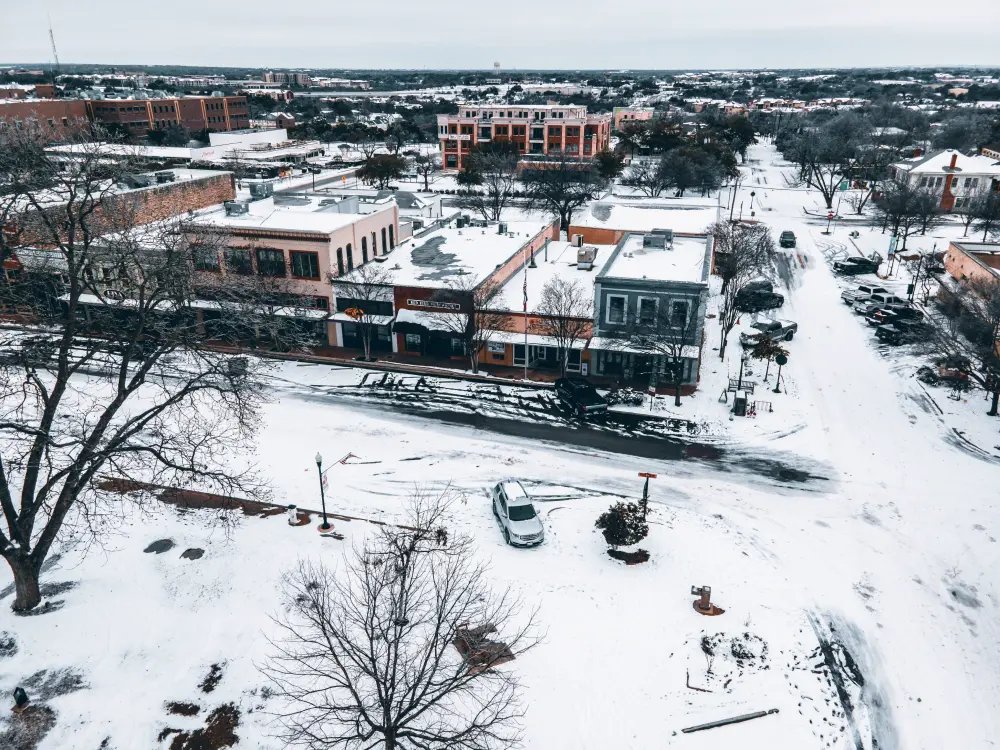Has the Texas Grid Been Winterized?
3 minute readIn February 2021, Winter Storm Uri brought record-breaking cold temperatures to Texas for nearly a week. This storm exposed a
Home > Learning Center > The Deregulated Texas Energy Market > Why Are Texas Electricity Prices So High?
6 minute read • Last update January 2025

The average price of electricity in Texas has increased 26% over the last several years thanks to a combination of different factors.
Increasing population and continuous electrification have consistently increased demand, severe weather conditions, rising utility (TDU) charges, and the state’s aging power grid. Here’s how the average residential electricity rate in Texas has changed since 2020, per the Energy Information Association.
Texas energy prices have steadily increased since 2002 when the state deregulated the energy market.
Since then, many factors have influenced growing electricity prices including demand, electrification, record-breaking high temperatures in the summer, winter storms that put the grid to a halt, the age of the energy infrastructure, and increasing transmission charges from utility companies.
There has never been a higher demand for energy in the state of Texas.
Per the 2000 United States census, the population of Texas was around 20 million people. In 2021, the population of Texas had grown to over 29 million people – that’s an increase of over 45%! There are more Americans flocking to Texas than to any other state except Florida.
This population boom means that power generation across the state has had to race to keep up to ensure that there is enough electricity to go around.
For anyone who has taken a macroeconomics course, it shouldn’t be surprising that high demand and a trailing supply lead to higher prices for energy.

The population boom of Texas impacts electricity prices in more ways than one.
While more people means more households and more demand for residential electricity, more people also means more commercial and industrial activity. Coffee shops, strip malls, restaurants, and skyscrapers full of offices all require energy to power our work days.
Additionally, our behavior around work has changed significantly in a way that has increased and lengthened peak demand hours.
Thanks to COVID, more people than ever are working from home and this has increased our demand for energy in the evening when solar power begins to decline. Declining solar energy makes it more difficult to meet the state’s energy needs.
The summers of 2011 and 2023 go down as the first and second hottest summers ever recorded in Texas, respectively.
The higher the thermometer goes, the more we expect from the energy grid to continue delivering higher and higher amounts of electricity to our homes to keep us cool and safe from the heat. Air conditioners have to work extra hard to cool our indoor air the hotter it gets outside.
These insanely high temps not only increase demand across the state, but they also impact the cost of energy production at plants fueled by our most significant energy source: natural gas.
At natural gas energy plants (which generate about 50% of the state’s power), high heat directly impacts the efficiency of the equipment needed to generate electricity. As temperatures rise, the turbines lose efficiency which means more natural gas is needed to produce the same amount of electricity that previously required less fuel.
This increased fuel consumption leads to higher operational costs which increases the prices that the power plants can sell the power to retail electricity providers (like BKV Energy) before it’s passed on to you, the consumer.
Retail energy providers don’t want to charge their customers higher prices. They want to offer affordable rates that are lower than their competitors to get more customers.
Unfortunately, the intertwined market conditions do not always allow REPs to sell energy to homeowners and renters at the prices they could several years ago.

In February 2021, Winter Storm Uri struck nearly the entire state of Texas, leaving millions without electricity for days. Even though people were prepared for the winter storm, several died in this tragedy.
During the storm, the prices of electricity increased significantly – several retail electricity providers went out of business as a result. The collapse of one wholesale retail electricity provider, Griddy, took center stage during the fallout of the storm.
But what about cold temperatures increases the price of electricity? As we’ve already mentioned, natural gas is Texas’ largest fuel source for generating electricity.
When temperatures drop too low like they did during Uri, natural gas pipelines that deliver fuel to the power plants can be frozen and the entire process is disrupted.
With less fuel heading to the power plants to spin the turbines that generate electric current, in combination with higher demand for heating in Texas homes across the state, the prices can skyrocket.
Cold weather can even have an impact on electricity pricing before the cold weather happens. Retail electricity providers purchase electricity from power plants in advance, forecasting how much energy they will need to provide for their customers in the future.
When power plants are uncertain about the future or believe that further history-making winter storms are on the way, the future prices of electricity increase as well.

The aging power grid in Texas also contributes to higher electricity prices across the state. There are three major issues that desperately need to be addressed to ensure power is delivered when people need it most.
1. Winterization
Our power plants across the state are not fully prepared to handle more storms like Uri in February 2021. Without enhancements such as enclosures around tanks, valves, and power lines, and protection for pipes to prevent freezing, we could see mass grid failure again.
During Winter Storm Uri, 50% of the natural gas power plants went offline, leading to disaster.
2. Increased transmission & infrastructure
In recent years, there has been a renewable energy boon in Texas. Texas generates the most wind power in the country, the second most solar power in the United States, and has an incredible amount of renewable energy slated for development.
There are a couple problems with this. We don’t have the infrastructure yet to store excess energy generated by wind and solar because the technology for this is still incredibly expensive. Storage is critical for renewables because the wind doesn’t always blow and the sun goes down at night – we can’t rely on these sources 24 hours of every day.
Another problem? We don’t have power lines to deliver enough of the electricity to parts of the state that are not geographically positioned for wind and solar farms of their own.
3. Interstate connections
The Texas grid is completely isolated from neighboring states. This means we must independently generate enough power for the state at all times – even during disaster.
If we were to construct connections to the grids of Oklahoma, Louisiana, Arkansas or New Mexico, we’d be able to draw power from them in times of need and vice versa.
There are some situations where this could be beneficial, but it is certainly not a one-size-fits-all solution because neighboring states experience similar weather patterns and similar energy demand. When we desperately need more energy supply, so do our neighbors.
When reading your monthly electricity bill, there are two main types of charges: the usage charge and the utility charge.
The usage charge pays for the electricity you’ve used throughout the past month and goes to your retail electricity provider of choice. The TDU charge goes straight to your utility company (e.g. Oncor in Dallas or Centerpoint in Houston) and pays for the management and maintenance of the infrastructure that delivers energy to your home, like the power lines.
Retail electricity providers have no control over how much TDU charges are. They are set every six months by your utility company and approved by the Public Utility Commission of Texas (PUCT).
Recently, TDU charges have been increasing. This is a financial fallout from the Winter Storm Uri. These utility companies are still paying for damage incurred by that devastating storm and hopefully, making improvements to the grid to prevent such a disaster from happening again.
Luckily, there are still many actions you can take to help reduce your monthly electricity bill. Follow these tips and you can significantly decrease your energy consumption, resulting in less pain for your budget and your wallet.
Looking for more energy saving hacks? Check out our curated list of 100 ways to reduce your electricity bill.
Explore BKV Energy’s affordable, fixed-rate energy plans by entering your zip code below.
Javier Hinojosa, Vice President of Retail Power at BKV Energy, has over fifteen years of management experience in M&A, consulting, supply chain, technology, and operations. He is responsible for overseeing all aspects of BKV Energy's business, from finance and brand development to customer service and go-to-market strategy.

In February 2021, Winter Storm Uri brought record-breaking cold temperatures to Texas for nearly a week. This storm exposed a

Switch holds are restrictions placed on electric meters that prevent customers from switching electricity providers. These statuses are meant to
Get $50 off your electric bill!
Use code BKVEJOINUS50
Enter your zip code to shop BKV Energy's affordable, fixed-rate Texas electricity plans. Use the promo code for $50 off your electric bill.